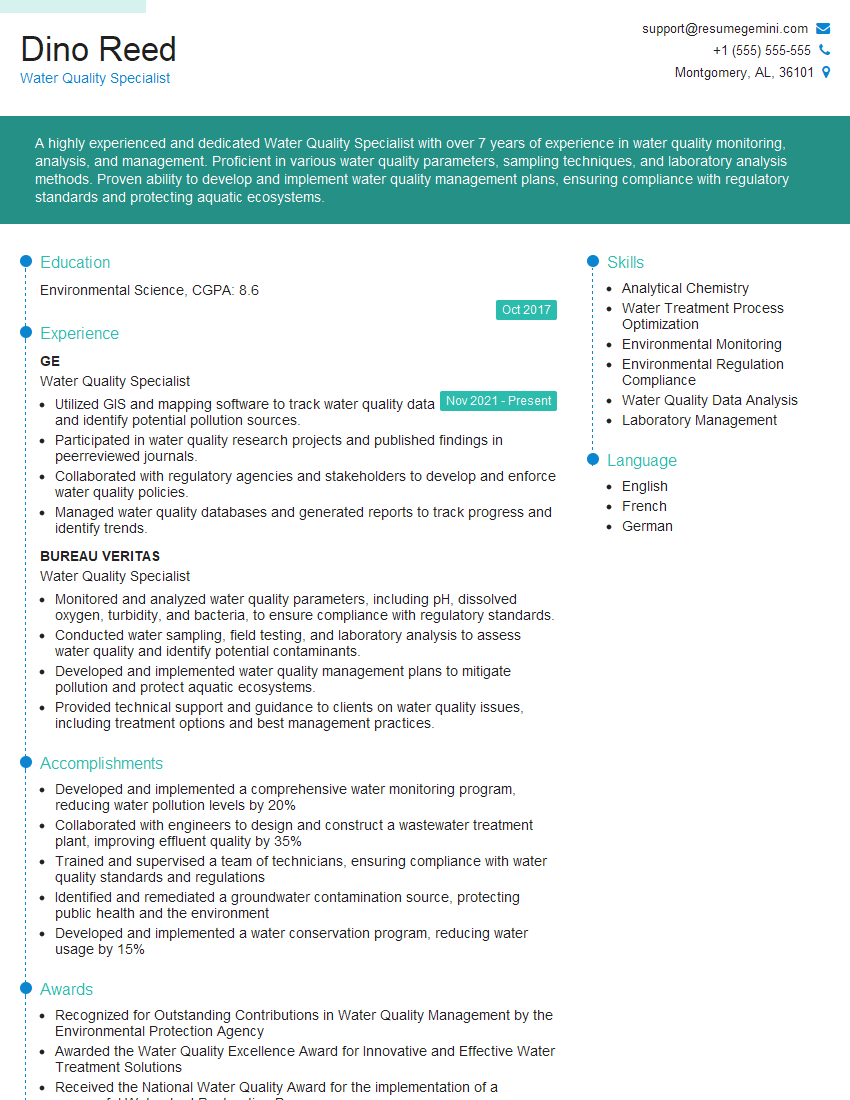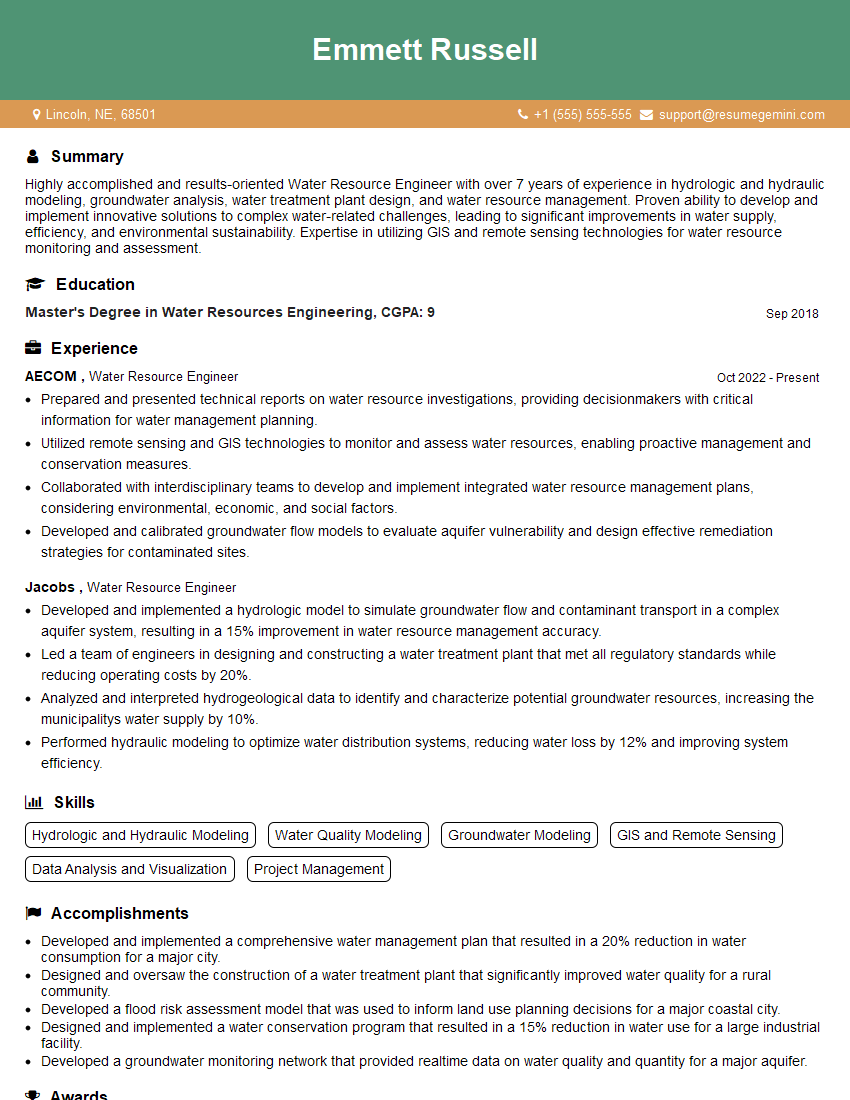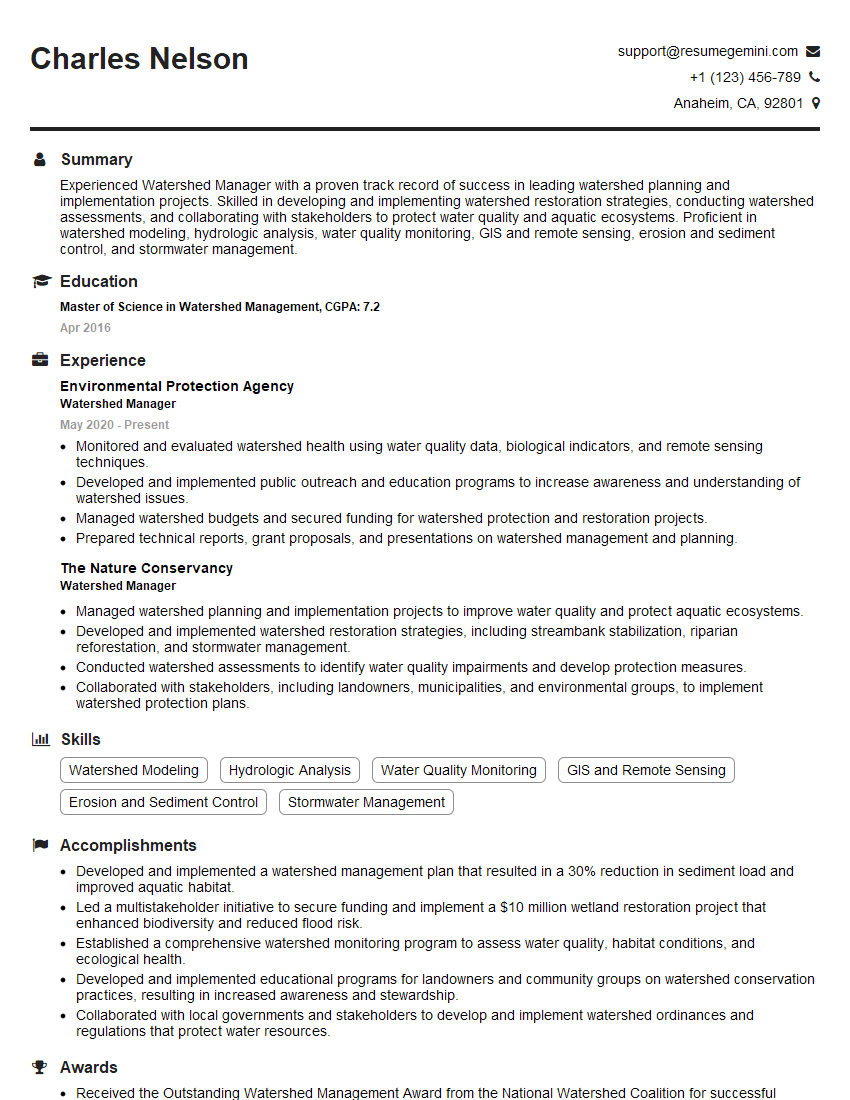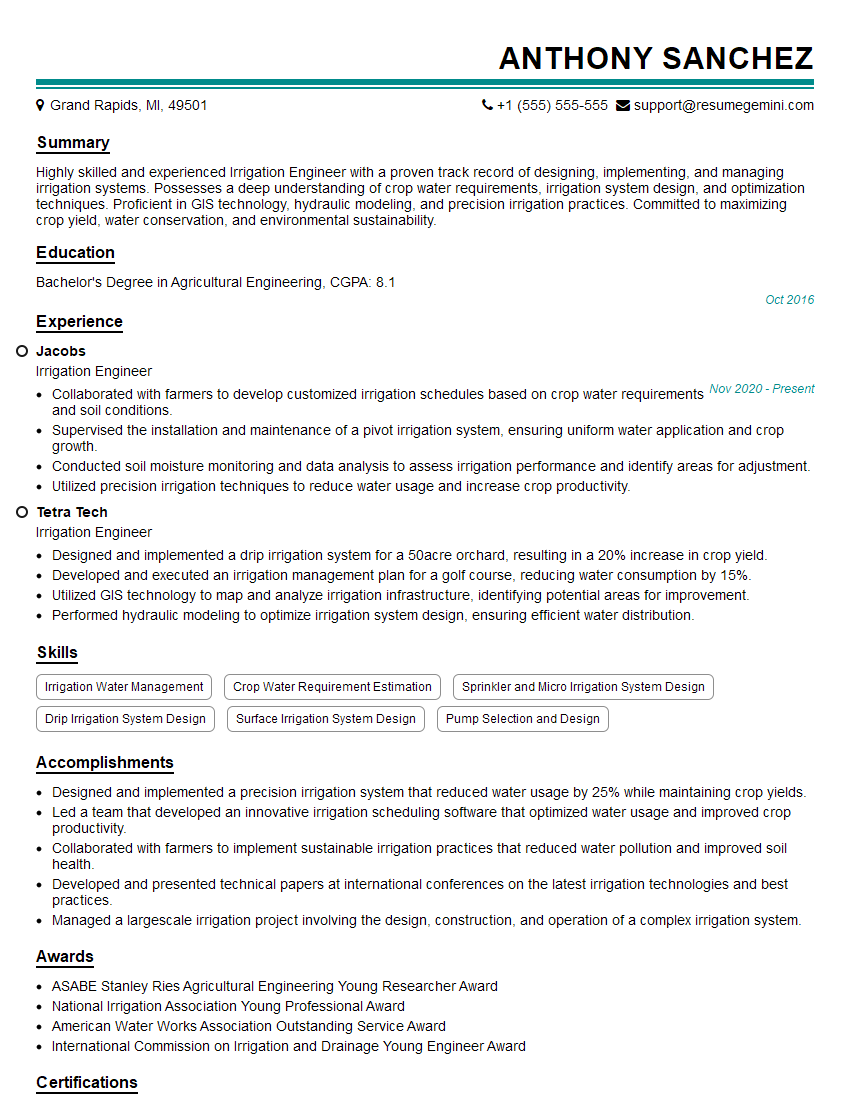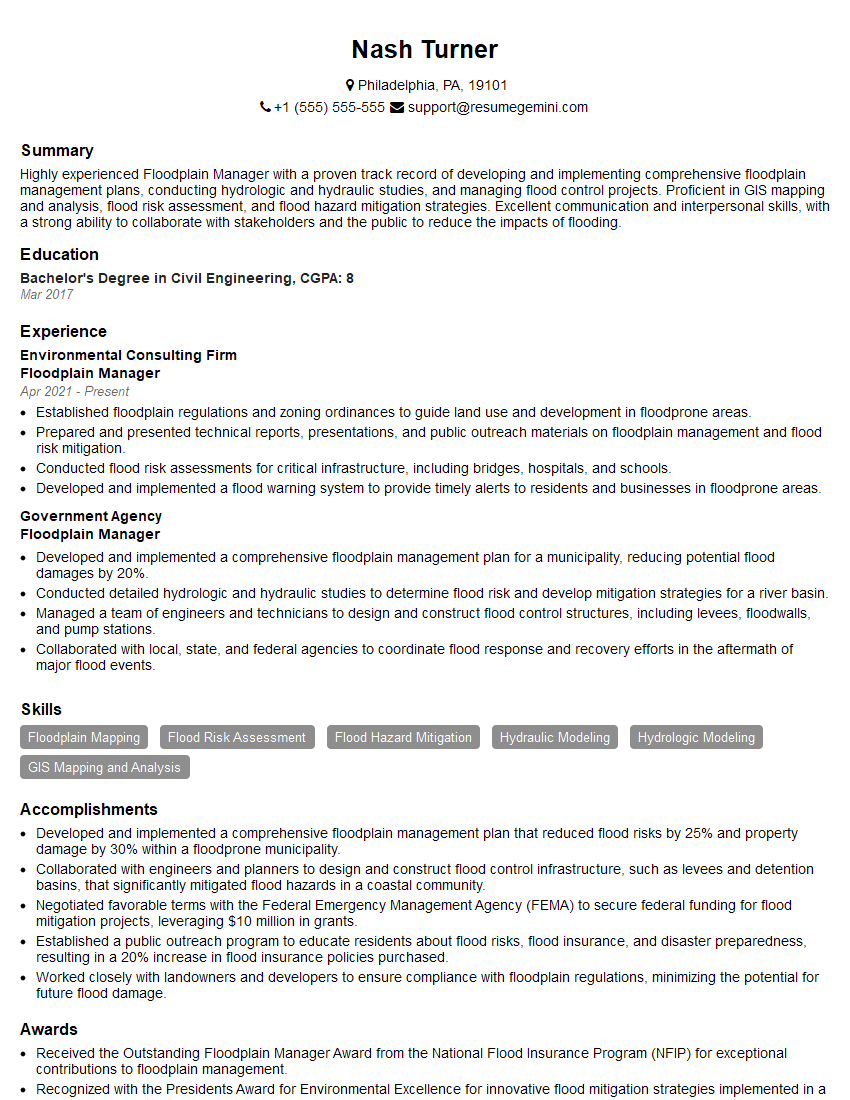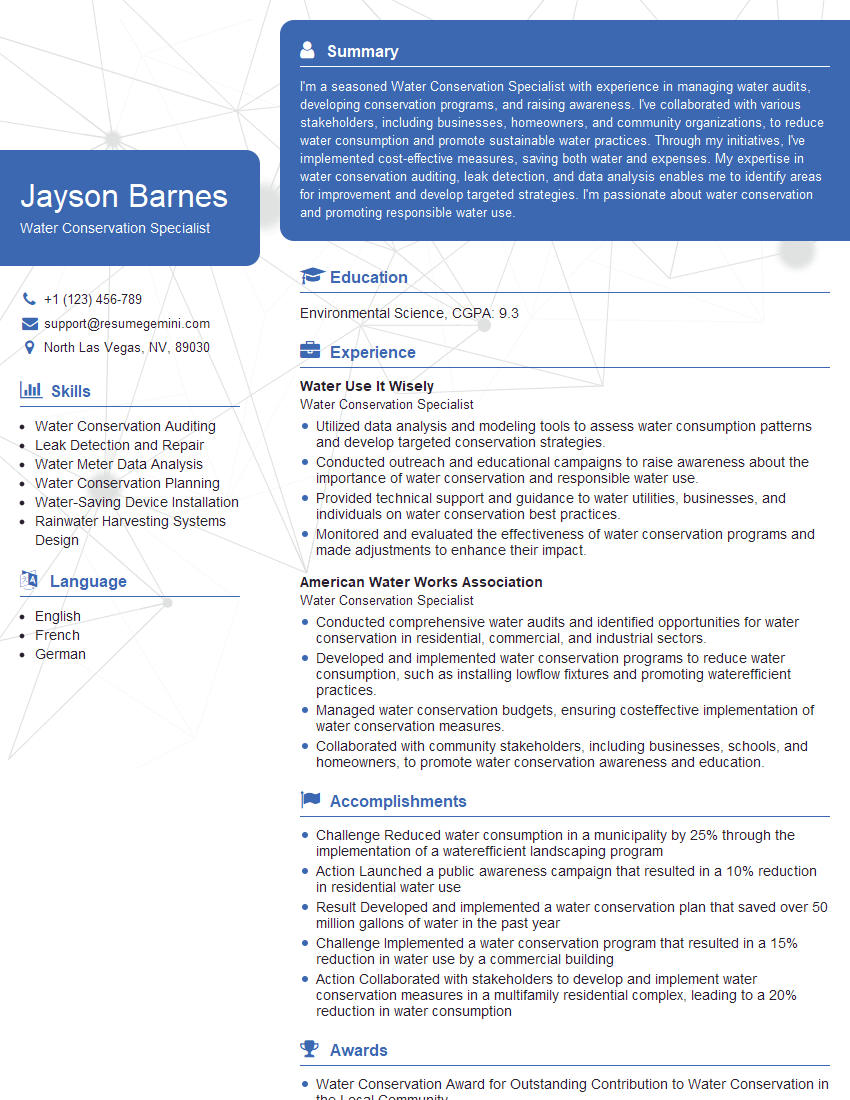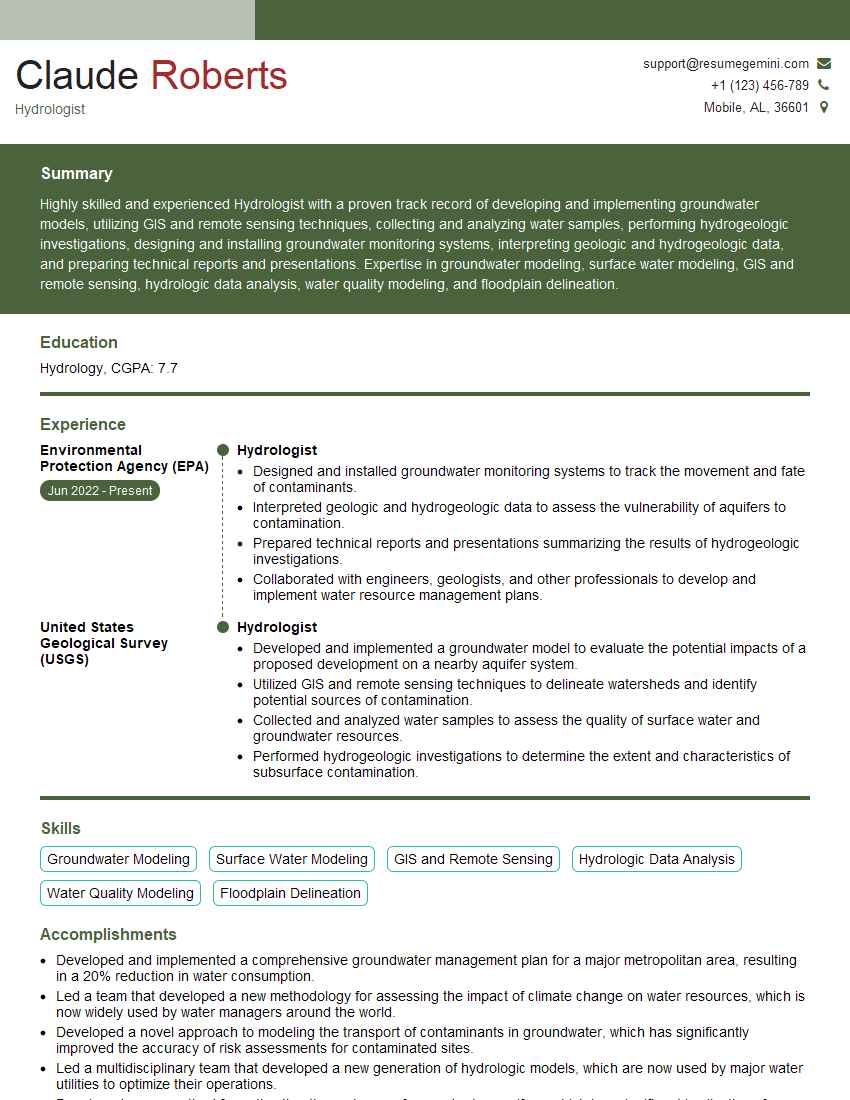Cracking a skill-specific interview, like one for Water Policy and Planning, requires understanding the nuances of the role. In this blog, we present the questions you’re most likely to encounter, along with insights into how to answer them effectively. Let’s ensure you’re ready to make a strong impression.
Questions Asked in Water Policy and Planning Interview
Q 1. Explain the difference between surface water and groundwater management.
Surface water management focuses on water bodies like rivers, lakes, and reservoirs, emphasizing flow regulation, flood control, and water quality protection. Think of it like managing a highway system – ensuring smooth flow, preventing bottlenecks (floods), and maintaining the road’s condition (water quality). Groundwater management, on the other hand, deals with aquifers – underground reservoirs. It’s more about sustainable extraction, preventing depletion, and avoiding saltwater intrusion. Imagine it as managing a vast, hidden network of pipes – you need to carefully monitor the pressure (water table) and prevent leaks (over-extraction).
Key differences include the accessibility (surface water is readily visible, groundwater isn’t), the rate of replenishment (surface water replenishes faster), and the governing legal frameworks (often different regulations for surface and groundwater). For example, surface water rights are frequently based on a ‘first-in-time, first-in-right’ doctrine, while groundwater rights can be more complex and vary significantly by location.
Q 2. Describe the key components of a comprehensive water resources management plan.
A comprehensive water resources management plan requires a holistic approach, encompassing several key components:
- Assessment: Thorough evaluation of water resources, including quantity, quality, and demand. This involves hydrological modelling, water balance studies, and the identification of key stakeholders.
- Planning & Prioritization: Defining goals and objectives, such as ensuring water security, optimizing water use, and protecting water ecosystems. This often involves prioritizing competing demands from agriculture, industry, and domestic use.
- Development & Implementation: Designing and implementing projects and programs such as dams, irrigation systems, wastewater treatment facilities, and water conservation measures. This involves procuring funding, securing permits and conducting environmental impact assessments.
- Monitoring & Evaluation: Tracking water resources, assessing the effectiveness of implemented projects, and adapting the plan based on monitoring data and changing conditions. This is crucial for ensuring the long-term success of the plan.
- Governance & Institutional Framework: Establishing clear responsibilities, regulatory mechanisms, and stakeholder participation processes. Collaboration among government agencies, private sector, and civil society is vital for successful implementation.
For example, a plan might involve implementing water-efficient irrigation techniques in agriculture alongside constructing new reservoirs to manage water supply during droughts. Effective communication and public engagement are also crucial components.
Q 3. What are the major challenges facing water resource management in your region?
(Note: This answer will vary depending on the specific region. The following is a general example focusing on common global challenges): Major challenges facing water resource management globally include:
- Climate Change: Increased frequency and intensity of droughts and floods disrupt water availability and quality.
- Population Growth: Rising populations increase water demand, putting pressure on already stressed resources.
- Pollution: Industrial, agricultural, and urban runoff contaminates water sources, impacting human health and aquatic ecosystems. This includes nutrient pollution leading to eutrophication.
- Water Infrastructure Deficiencies: Inadequate infrastructure for water supply, treatment, and distribution leads to water scarcity and waterborne diseases.
- Governance and Institutional Weaknesses: Lack of clear water policies, ineffective regulatory frameworks, and poor coordination among stakeholders hinder efficient water management.
- Transboundary Water Issues: Shared water resources often lead to conflicts between countries or regions due to differing priorities and management approaches.
For instance, in many arid and semi-arid regions, groundwater over-extraction is a significant challenge leading to land subsidence and saltwater intrusion.
Q 4. How do you assess the sustainability of a water resource project?
Assessing the sustainability of a water resource project requires a multi-faceted approach that goes beyond simply evaluating its economic viability. A sustainable project must be environmentally sound, socially equitable, and economically feasible in the long term. Key assessments include:
- Environmental Impact Assessment (EIA): Evaluating potential effects on water quality, ecosystems, biodiversity, and climate change. This often includes modelling to predict potential changes.
- Social Impact Assessment (SIA): Assessing the project’s effects on local communities, including livelihood impacts, displacement, and access to water. Public participation and consultation are crucial.
- Economic Viability Assessment: Analyzing the project’s cost-effectiveness, financial sustainability, and economic benefits. A life-cycle cost analysis is essential.
- Water Security Assessment: Examining how the project contributes to long-term water security, considering future climate change projections and population growth.
- Governance and Institutional Capacity Assessment: Determining whether the project aligns with existing regulations and if the necessary institutional capacity exists for its successful management and maintenance.
For example, a dam project might be assessed for its potential impact on downstream ecosystems, the displacement of communities, and its overall economic benefits considering its lifespan and maintenance costs.
Q 5. Discuss the role of water pricing in efficient water allocation.
Water pricing plays a crucial role in efficient water allocation by reflecting the true cost of water, including extraction, treatment, and distribution. It incentivizes conservation and efficient water use. Different pricing mechanisms can be used, such as:
- Uniform Pricing: A fixed price per unit of water regardless of consumption. This approach is simple but doesn’t incentivize conservation.
- Block Pricing: Different prices for different consumption blocks. This encourages conservation by charging higher prices for higher consumption levels.
- Seasonal Pricing: Varying prices based on the season, reflecting higher demand during dry periods. This helps to balance water use throughout the year.
- Real-time Pricing: Prices fluctuate based on real-time water availability and demand. This can provide the strongest incentives for conservation.
It’s important to consider affordability and social equity when implementing water pricing, ensuring access to affordable water for vulnerable populations. Subsidies may be necessary to achieve both efficiency and equity.
For example, a city might implement block pricing where the first few units of water are inexpensive, encouraging essential household needs, and then prices increase dramatically for larger consumption, discouraging wasteful practices.
Q 6. Explain the concept of integrated water resources management (IWRM).
Integrated Water Resources Management (IWRM) is a holistic approach that considers all aspects of water management, including supply, demand, and environmental protection. Instead of managing water resources sectorally (e.g., solely for irrigation or hydropower), IWRM promotes an integrated approach that considers the interconnectedness of different water uses and ecosystems. Key principles include:
- Holistic Approach: Considering all water uses and impacts within a basin or region.
- Stakeholder Participation: Involving all relevant stakeholders in decision-making.
- Long-Term Perspective: Planning for sustainability over the long term.
- Adaptive Management: Adapting strategies based on monitoring and evaluation.
- Ecosystem Approach: Protecting and restoring aquatic ecosystems.
For example, IWRM might involve balancing agricultural water demands with the needs of maintaining downstream river flows for aquatic life and recreation. This requires collaboration among farmers, environmental agencies, and other stakeholders.
Q 7. What are some common methods used for water quality monitoring?
Water quality monitoring employs various methods to assess the chemical, physical, and biological characteristics of water. Common methods include:
- Physical Monitoring: Measuring parameters like temperature, turbidity (cloudiness), pH, conductivity (salinity), and dissolved oxygen.
- Chemical Monitoring: Analyzing the concentration of pollutants such as nutrients (nitrogen and phosphorus), heavy metals, pesticides, and organic compounds. Techniques include chromatography and spectrophotometry.
- Biological Monitoring: Assessing the presence and abundance of aquatic organisms (bioindicators) that are sensitive to pollution. This can reveal the overall health of the aquatic ecosystem.
- Microbiological Monitoring: Testing for the presence of pathogens such as bacteria, viruses, and parasites that can cause waterborne diseases. This is crucial for ensuring drinking water safety.
- Remote Sensing: Using satellite imagery and aerial photography to monitor water quality parameters such as chlorophyll concentration (indicative of algae blooms) and turbidity over large areas.
The specific methods used depend on the intended use of the water and the types of pollutants of concern. Data collected from monitoring is essential for identifying pollution sources, tracking water quality trends, and implementing appropriate management strategies.
Q 8. How do you evaluate the environmental impact of a water development project?
Evaluating the environmental impact of a water development project requires a holistic approach, considering both direct and indirect effects. We use a variety of tools and methodologies, often incorporating environmental impact assessments (EIAs).
Direct impacts might include changes in water flow regimes (e.g., reduced downstream flow due to dam construction), habitat alteration (e.g., loss of riparian vegetation due to reservoir creation), and changes in water quality (e.g., increased sedimentation or nutrient loading). We assess these through field surveys, hydrological modeling, and water quality analysis. For example, we might measure dissolved oxygen levels upstream and downstream of a proposed dam to predict the impact on aquatic life.
Indirect impacts can be more complex and harder to predict. These might include changes in land use patterns (e.g., increased irrigation leading to deforestation), impacts on biodiversity (e.g., changes in species distribution or abundance), and greenhouse gas emissions (e.g., methane release from reservoirs). We use Life Cycle Assessment (LCA) techniques to evaluate these indirect impacts.
The assessment typically includes a baseline study, an impact prediction (using modeling and expert judgment), and mitigation strategies to minimize negative effects. For instance, if a project leads to habitat loss, we might recommend creating compensatory habitat elsewhere. The results of the EIA are crucial in decision-making and inform the project design and implementation.
Q 9. Describe different water conservation techniques and their effectiveness.
Water conservation involves implementing strategies to reduce water consumption while ensuring sufficient supply for essential needs. Effective techniques vary depending on the context (domestic, agricultural, industrial) but generally fall under several categories.
- Improved irrigation efficiency: Techniques like drip irrigation, sprinkler systems (with optimized pressure), and rainwater harvesting significantly reduce water use in agriculture. For example, switching from flood irrigation to drip irrigation can reduce water consumption by 50% or more.
- Water-efficient appliances and fixtures: In domestic settings, low-flow showerheads, toilets, and faucets greatly reduce water wastage. These simple changes can have a cumulative impact on water savings at a household and community level.
- Industrial water recycling and reuse: Industries can implement closed-loop systems where wastewater is treated and reused in production processes, minimizing fresh water consumption. This is particularly crucial in water-stressed regions.
- Public awareness campaigns: Educating the public about water conservation practices through campaigns and educational programs is vital to encourage behavioral changes. For instance, public service announcements on efficient water use during droughts can create significant impact.
- Leak detection and repair: Promptly fixing leaks in water distribution systems can save substantial amounts of water, particularly in aging infrastructure. Regular pipeline inspections and pressure management are crucial.
The effectiveness of these techniques depends on factors such as their implementation, community participation, and technological advancements. A combination of these techniques is usually needed for a comprehensive water conservation strategy.
Q 10. What are the legal and regulatory frameworks governing water use in your area?
(Note: This answer will be tailored to a specific area. Replace the bracketed information with the relevant legal and regulatory framework for your chosen region. For this example, a generalized framework will be provided.)
Water use is governed by a complex interplay of laws, regulations, and policies. These vary significantly by location but generally address water allocation, quality standards, and environmental protection. A typical framework might include:
- Water rights laws: These laws define how water is owned and allocated, often involving a system of permits or licenses. This might include the prioritization of water use for specific purposes (e.g., domestic use over industrial use during scarcity). [Specific example of water rights legislation in the chosen region]
- Water quality standards: These set limits on pollutants allowed in water bodies to protect human health and the environment. [Reference specific legislation regarding water quality standards. Examples: Clean Water Act (US), Water Framework Directive (EU)]
- Environmental protection laws: These laws aim to preserve aquatic ecosystems and prevent degradation through measures such as wetland protection and riparian buffer zone regulations. [Specific example of environmental legislation impacting water resources]
- Water resource management agencies: Regulatory bodies are responsible for implementing and enforcing water laws, issuing permits, and monitoring water quality. [Name and role of relevant government agencies]
These frameworks are dynamic and often undergo revisions to accommodate changing conditions, new technologies, and evolving environmental concerns. Navigating this regulatory landscape requires expertise in water law and policy.
Q 11. Explain the concept of water rights and their allocation.
Water rights refer to the legal and equitable entitlements to use water from a particular source. The allocation of these rights is a critical aspect of water management. Systems vary widely, but some common approaches include:
- Prior appropriation: This system, common in the western United States, grants water rights based on historical use and priority. The first user to divert water for beneficial use has the highest priority.
- Riparian rights: In this system, landowners adjacent to a water body have the right to use water from that body. The amount of water they can use is typically related to the size of their landholding and the nature of their use.
- Permitting systems: Many jurisdictions use permitting systems to allocate water rights, where users must obtain a permit to withdraw water. Permits often specify the amount of water allowed, the location of withdrawal, and the purposes of use.
Allocation methods often involve balancing competing demands from various users, including agriculture, industry, domestic use, and environmental needs. This often necessitates complex processes like water market mechanisms (trading water rights) or integrated water resource management (IWRM) approaches, which consider the social, economic, and environmental dimensions of water allocation. Conflicts over water rights are common, and their resolution frequently involves legal processes and negotiations.
Q 12. How do you model water flow in a river system?
Modeling water flow in a river system involves using mathematical representations to simulate the movement of water through the system. This is done using hydrological models, which are computer programs that simulate the processes governing water flow, such as rainfall, runoff, infiltration, evapotranspiration, and channel flow.
Commonly used models include:
- HEC-RAS (Hydrologic Engineering Center’s River Analysis System): This widely used model simulates one-dimensional unsteady flow in open channels and is excellent for flood forecasting and hydraulic design.
- MIKE 11 (DHI): A powerful model capable of simulating one-dimensional and two-dimensional flow, including hydrodynamic and water quality processes.
- SWAT (Soil and Water Assessment Tool): A physically-based, distributed model that simulates hydrological processes at a watershed scale and can be used for long-term impact assessments.
The process typically involves defining the river network, setting model parameters (e.g., channel geometry, roughness coefficients, rainfall data), calibrating the model against observed flow data, and validating the model’s accuracy. The calibrated model can then be used to predict future flows under various scenarios, such as climate change impacts or changes in land use.
Example of a simplified flow equation: Q = A * V where Q is discharge, A is the cross-sectional area of the channel, and V is the flow velocity. Hydrological models use far more complex equations to account for various factors influencing water flow.
Q 13. Describe the process of conducting a water balance study.
A water balance study quantifies the inflows and outflows of water within a defined system (e.g., a watershed, reservoir, or irrigation scheme) over a specified period. The basic equation is:
Precipitation + Inflows - Evaporation - Outflows - Groundwater Recharge/Discharge = Change in Storage
The process involves:
- Defining the system boundaries: Clearly delineating the area for which the water balance will be calculated.
- Data collection: Gathering data on precipitation (rainfall, snowfall), surface water inflows and outflows (river flows, irrigation diversions), evapotranspiration (water loss from evaporation and plant transpiration), and groundwater recharge and discharge. This often involves using rain gauges, stream flow gauges, and remote sensing techniques.
- Data analysis: Analyzing the collected data to quantify the various components of the water balance equation.
- Modeling (optional): Using hydrological models to simulate water flow and estimate components that are difficult to measure directly, such as evapotranspiration or groundwater recharge.
- Water balance calculation: Calculating the change in water storage over time based on the quantified inflows and outflows.
- Uncertainty analysis: Assessing the uncertainty associated with the estimated components of the water balance.
The results of a water balance study provide valuable insights into the water resources of the system and can inform management decisions, such as irrigation scheduling, reservoir operation, or water allocation policies. For instance, a negative water balance in a reservoir indicates water loss, highlighting the need for improved water management practices.
Q 14. What are some common water-related risks and how can they be mitigated?
Water-related risks are diverse and pose significant challenges to communities and ecosystems. Some common risks include:
- Water scarcity: A lack of sufficient freshwater resources to meet demands, often exacerbated by population growth, climate change, and unsustainable water use.
- Flooding: Excessive rainfall or rapid snowmelt can overwhelm drainage systems, leading to widespread damage and loss of life. Climate change is intensifying this risk.
- Droughts: Extended periods of low rainfall can cause severe water shortages, impacting agriculture, industry, and ecosystems.
- Water pollution: Contamination of water sources by pollutants, such as industrial waste, agricultural runoff, and sewage, poses risks to human health and the environment.
- Waterborne diseases: Contaminated water can transmit diseases such as cholera, typhoid, and diarrhea, especially in areas with inadequate sanitation.
Mitigation strategies vary depending on the specific risk but generally involve a combination of:
- Sustainable water management: Implementing efficient water use practices, improving water infrastructure, and protecting water resources.
- Flood risk management: Implementing flood control measures, such as dams, levees, and early warning systems.
- Drought preparedness: Developing drought contingency plans, promoting water conservation, and investing in drought-resistant crops.
- Pollution control: Implementing regulations and technologies to reduce water pollution from various sources.
- Improved sanitation and hygiene: Providing access to safe drinking water and sanitation facilities to reduce waterborne diseases.
Effective mitigation requires integrated approaches that consider the interconnectedness of water resources and the social, economic, and environmental dimensions of risk. Community participation and collaborative planning are crucial in building resilience to water-related risks.
Q 15. Explain the role of GIS in water resource management.
Geographic Information Systems (GIS) are indispensable tools in water resource management, offering a powerful platform to visualize, analyze, and manage spatial data related to water. Imagine a map showing not just rivers and lakes, but also groundwater levels, rainfall patterns, population density, and land use – all integrated into a single system. That’s the power of GIS.
GIS allows for:
- Spatial Data Integration: Combining data from various sources, such as rainfall gauges, well measurements, and satellite imagery, to create a comprehensive picture of water resources.
- Water Quality Monitoring: Mapping pollution sources and tracking the spread of contaminants, enabling targeted remediation efforts. For instance, we can overlay pollution data with population density to identify areas needing urgent attention.
- Watershed Management: Defining watershed boundaries, analyzing hydrological processes, and planning for sustainable water use within those boundaries. A GIS model can simulate the impact of land-use changes on water flow and quality.
- Infrastructure Management: Managing and optimizing the location and performance of water infrastructure such as dams, pipelines, and treatment plants. For example, using GIS for optimal placement of new wells or pipelines can greatly enhance efficiency.
- Water Allocation and Planning: Supporting decision-making processes related to water allocation among different users and developing water management strategies. GIS allows for ‘what-if’ scenarios to assess the impacts of different allocation strategies.
In essence, GIS provides a holistic and visual understanding of complex water systems, enabling informed decision-making and effective resource management.
Career Expert Tips:
- Ace those interviews! Prepare effectively by reviewing the Top 50 Most Common Interview Questions on ResumeGemini.
- Navigate your job search with confidence! Explore a wide range of Career Tips on ResumeGemini. Learn about common challenges and recommendations to overcome them.
- Craft the perfect resume! Master the Art of Resume Writing with ResumeGemini’s guide. Showcase your unique qualifications and achievements effectively.
- Don’t miss out on holiday savings! Build your dream resume with ResumeGemini’s ATS optimized templates.
Q 16. How do you communicate complex water-related information to non-technical audiences?
Communicating complex water-related information to non-technical audiences requires simplifying technical jargon and using visual aids. Instead of discussing ‘hydrological modeling,’ I’d talk about ‘predicting future water availability.’ Instead of ‘aquifer depletion,’ I’d say ‘running out of groundwater’.
Effective strategies include:
- Visualizations: Maps, charts, and graphs are powerful tools. A simple bar graph showing water consumption trends is far more accessible than a complex statistical table.
- Storytelling: Frame information within a narrative that connects with people’s lives and experiences. For example, instead of focusing on abstract statistics, I might share the story of a community facing water scarcity.
- Analogies and Metaphors: Relate complex concepts to everyday experiences. Comparing groundwater to a bank account, explaining over-extraction as overdraft, helps grasp the consequences of unsustainable practices.
- Interactive Tools: Online platforms and apps can make data more accessible and engaging, allowing users to explore information at their own pace.
- Plain Language: Avoid technical terms whenever possible. If you must use jargon, clearly define it.
For example, I recently explained the concept of water stress to a group of farmers using a simple analogy of a bathtub that was slowly being filled less and less. This helped them visualize the implications for their crops.
Q 17. What are the key performance indicators (KPIs) for assessing water management effectiveness?
Key Performance Indicators (KPIs) for assessing water management effectiveness vary depending on the specific goals and context. However, some crucial indicators include:
- Water Availability (per capita): Indicates the amount of available water per person. A decline signals increasing scarcity.
- Water Stress Index: Measures the ratio of total water withdrawals to available renewable water resources. High values indicate stress on the water system.
- Groundwater Level Changes: Tracking groundwater levels over time helps to monitor aquifer health and identify unsustainable extraction.
- Water Quality Parameters: Assessing parameters like dissolved oxygen, turbidity, and nutrient levels reveals the health of water bodies.
- Water Loss/Leakage Rate: Measures the efficiency of water distribution networks. High rates indicate losses due to leakage and require maintenance.
- Compliance with Regulations: Assessing adherence to water quality standards and regulations is essential for maintaining environmental protection.
- Public Satisfaction: Gauging public satisfaction with water services and responsiveness of water management authorities is crucial for ensuring stakeholder engagement.
It’s important to use a combination of these KPIs, tailored to the specific needs and context of the water management system being evaluated. For example, in an arid region, the focus might be on water conservation and groundwater management, while in a region with significant water pollution, the emphasis might be on water quality parameters.
Q 18. Describe your experience with water demand forecasting.
My experience in water demand forecasting involves using a variety of methods, ranging from simple time-series analysis to more complex econometric modeling, integrating socio-economic factors and climate projections. It’s not just about predicting numbers; it’s about understanding the underlying drivers of demand.
For example, in a recent project, we used a combination of regression analysis and population growth projections to forecast municipal water demand over the next 25 years. We considered factors like per capita water consumption (influenced by economic growth and water pricing policies), population growth projections from census data, and anticipated shifts in land use patterns.
We also incorporated climate change projections, as shifts in temperature and rainfall patterns can significantly impact water demand, both for agriculture and domestic consumption. These projections informed the development of a long-term water management strategy to ensure the region’s future water security.
The accuracy of forecasts relies heavily on the quality of input data and the selection of appropriate modeling techniques. Regularly updating and validating our models with actual data is crucial for improving forecast accuracy and adaptation to changing conditions.
Q 19. Discuss the challenges of managing transboundary water resources.
Managing transboundary water resources presents unique challenges due to the involvement of multiple countries, each with their own priorities and interests. These challenges often involve:
- Conflicting Water Uses: Upstream countries may prioritize hydropower generation, while downstream countries depend on the water for irrigation and drinking. These conflicting uses often lead to tension.
- Data Scarcity and Transparency: Lack of shared data on water availability, quality, and usage hinders cooperation and creates distrust among stakeholders.
- Unequal Power Dynamics: Countries with greater political and economic power may exert disproportionate influence over water allocation decisions, leading to inequitable outcomes.
- Lack of Institutional Frameworks: The absence of robust international agreements and institutions to govern water sharing can exacerbate conflict.
- Environmental Concerns: Upstream activities, such as dam construction or pollution, can have significant downstream environmental impacts.
Addressing these challenges requires international cooperation, diplomatic negotiations, and the establishment of fair and equitable water sharing agreements. This often involves collaborative data sharing, joint monitoring programs, and the development of mutually beneficial water management strategies. The Nile River basin, with its numerous riparian countries and diverse water needs, serves as a compelling example of the complexities involved in transboundary water management.
Q 20. Explain the principles of water reuse and recycling.
Water reuse and recycling involve treating wastewater to remove pollutants and make it suitable for non-potable uses. It’s a crucial strategy for sustainable water management, particularly in water-scarce regions. The principles revolve around:
- Treatment Technologies: Employing appropriate treatment processes to remove contaminants, depending on the intended reuse application. This could include advanced treatment methods such as membrane filtration, reverse osmosis, and ultraviolet disinfection.
- Reuse Pathways: Defining the appropriate reuse pathways for treated wastewater. This could include irrigation, industrial processes, toilet flushing, or groundwater recharge.
- Risk Assessment and Management: Conducting comprehensive risk assessments to identify potential health and environmental risks associated with water reuse and developing strategies to mitigate these risks.
- Public Acceptance: Building public trust and acceptance through transparent communication, education, and community engagement is crucial for successful implementation of water reuse projects.
- Regulatory Framework: Establishing clear regulations and standards for treated wastewater quality to protect public health and the environment.
For example, many cities successfully use treated wastewater for irrigation in parks and golf courses, reducing their reliance on freshwater sources. Singapore’s ‘NEWater’ program is a prime example of large-scale water recycling for potable use, showcasing advanced treatment technologies and successful public acceptance.
Q 21. How do you address conflicts between different water users?
Addressing conflicts between different water users requires a multi-faceted approach emphasizing collaboration, negotiation, and mediation.
Effective strategies include:
- Water Allocation Frameworks: Developing fair and equitable water allocation frameworks based on principles of sustainability, efficiency, and social equity. This might involve establishing priorities for different uses based on societal needs and environmental protection.
- Negotiation and Mediation: Facilitating dialogue and negotiation between conflicting parties to find mutually acceptable solutions. Mediation by impartial third parties can assist in finding compromises.
- Water Pricing Mechanisms: Implementing efficient water pricing policies that reflect the true cost of water and incentivize conservation. This can discourage overuse and promote more equitable distribution.
- Water Demand Management: Implementing programs to reduce water demand through efficiency improvements, technological innovations, and public awareness campaigns.
- Legal and Regulatory Frameworks: Establishing strong legal frameworks to resolve water disputes and ensure compliance with regulations.
- Integrated Water Resources Management (IWRM): Adopting an IWRM approach that integrates the needs of all water users and considers the environmental implications of water management decisions.
For instance, in resolving conflicts between agricultural and urban water users, a successful strategy might involve investing in water-efficient irrigation technologies for agriculture, while simultaneously implementing water conservation measures in urban areas. This balanced approach promotes equitable water use while protecting the environment.
Q 22. What are some innovative approaches to water management?
Innovative approaches to water management are crucial in addressing growing water scarcity and pollution. These approaches move beyond traditional methods and incorporate cutting-edge technologies and collaborative strategies.
- Smart irrigation technologies: Using sensors and data analytics to optimize irrigation scheduling, reducing water waste by up to 50%. For example, soil moisture sensors can tell farmers exactly when and how much water their crops need, avoiding overwatering.
- Water reuse and recycling: Treating wastewater to a high standard for non-potable uses like irrigation or industrial processes. This significantly reduces reliance on freshwater sources. Singapore, for instance, has a highly developed NEWater program that recycles wastewater for industrial and non-potable purposes.
- Rainwater harvesting: Collecting and storing rainwater for various uses, reducing demand on municipal water supplies, particularly in areas with seasonal rainfall. This can be implemented at both household and community levels.
- Integrated Water Resources Management (IWRM): A holistic approach that considers all aspects of water management – supply, demand, quality, and the environment – within a specific basin or region. This promotes integrated planning and collaboration among stakeholders.
- Nature-based solutions: Utilizing natural processes to manage water, such as restoring wetlands to improve water quality and flood control. Wetlands act as natural filters, removing pollutants from water before it reaches rivers and lakes.
Q 23. Discuss the role of climate change in influencing water resources.
Climate change significantly impacts water resources, altering the hydrological cycle in several ways.
- Changes in precipitation patterns: Some regions experience increased intensity and frequency of rainfall leading to flooding, while others face prolonged droughts and reduced water availability. This uneven distribution creates challenges for water management and resource allocation.
- Glacier melt and snowpack reduction: Rising temperatures accelerate the melting of glaciers and snowpack, initially increasing river flows but eventually leading to decreased long-term water availability for downstream communities reliant on these sources. The Himalayan glaciers, for example, are a critical source of water for millions in South Asia, and their accelerated melting poses a significant threat.
- Sea-level rise and saltwater intrusion: Rising sea levels contaminate coastal aquifers with saltwater, rendering them unusable for drinking water and agriculture. This affects low-lying coastal communities and agricultural lands significantly.
- Increased evaporation rates: Higher temperatures increase evaporation from reservoirs and lakes, reducing water storage capacity and availability. This necessitates improved water conservation and storage strategies.
Understanding these climate change impacts is vital for developing resilient water management strategies, including adapting water infrastructure and implementing drought-resistant crops.
Q 24. How do you use data analysis to inform water policy decisions?
Data analysis plays a central role in informing water policy decisions. By leveraging various data sources, we can gain insights into water availability, demand, quality, and the effectiveness of management strategies.
- Hydrological data: Rainfall, streamflow, groundwater levels, and reservoir storage data are analyzed to understand water availability and variability. This data is often collected through monitoring networks and analyzed using statistical methods and hydrological models.
- Water quality data: Data on nutrient levels, pollutants, and pathogens helps assess water quality and identify pollution sources. This information is used to develop and evaluate water quality management strategies.
- Water use data: Data on water consumption patterns in different sectors (agriculture, industry, domestic) helps us understand water demand and identify areas for improvement in water efficiency.
- Socio-economic data: Data on population, demographics, and economic activities helps understand the demand for water and plan for future needs. Integrating this with hydrological data enables us to predict future water stress scenarios.
Tools like GIS (Geographic Information Systems) and statistical software are used to analyze and visualize this data, supporting evidence-based decision-making in water policy development. For instance, spatial analysis can identify vulnerable areas or pinpoint pollution sources, leading to targeted interventions.
Q 25. Describe your experience with water quality modeling.
My experience with water quality modeling involves using various software packages and techniques to simulate and predict water quality changes in rivers, lakes, and aquifers. This involves building mathematical models that represent the physical, chemical, and biological processes affecting water quality.
I have used models such as QUAL2K and MIKE 11 to simulate the transport and fate of pollutants in surface water systems. These models require input data like flow rates, pollutant concentrations, and water quality parameters. The output provides predictions of water quality conditions under different scenarios, helping to assess the effectiveness of different management strategies. For example, I have used such models to assess the impact of wastewater discharge on a river’s water quality, helping to develop strategies for reducing pollution.
Furthermore, I have experience with groundwater modeling, using MODFLOW to simulate groundwater flow and transport of contaminants. This is crucial for managing groundwater resources sustainably and preventing contamination of drinking water supplies. In one project, we used MODFLOW to assess the impact of agricultural practices on nitrate contamination of groundwater, informing policy recommendations for sustainable agricultural practices.
Q 26. How do you ensure the equitable distribution of water resources?
Ensuring equitable distribution of water resources is a complex challenge, requiring a multi-faceted approach that balances competing demands and considers the needs of all stakeholders.
- Water allocation policies: Fair and transparent water allocation policies are essential. These policies should consider the needs of different users (agriculture, industry, domestic), prioritize essential uses, and incorporate environmental flow requirements.
- Water pricing mechanisms: Implementing progressive water pricing structures that incentivize efficient water use can help ensure equitable distribution. This might involve higher prices for larger water users or subsidies for low-income households.
- Participatory water management: Engaging communities in the planning and management of water resources is crucial for ensuring that their needs are met. This includes involving local communities in decision-making processes and building their capacity to manage their water resources.
- Conflict resolution mechanisms: Establishing robust mechanisms for addressing water conflicts between different users and communities is crucial. This involves mediating disputes, negotiating water sharing agreements, and enforcing regulations.
For example, in some arid regions, traditional water management systems based on community participation and equitable allocation have been successful in managing scarce water resources for generations. Modern approaches should aim to build on such successes and adapt them to new challenges.
Q 27. Explain your experience with stakeholder engagement in water management projects.
Stakeholder engagement is fundamental to successful water management projects. My experience involves working with diverse groups, including government agencies, communities, industry representatives, and environmental NGOs. I have used a variety of approaches to ensure meaningful participation.
- Participatory workshops and forums: Organizing workshops and forums to discuss project goals, challenges, and potential solutions, ensuring that all stakeholders have a voice.
- Surveys and interviews: Collecting data on stakeholders’ needs, preferences, and concerns through surveys and interviews to better understand their perspectives.
- Community consultations: Holding meetings in communities to discuss project impacts and address local concerns.
- Conflict resolution techniques: Utilizing negotiation and mediation techniques to resolve disagreements and build consensus among stakeholders.
In one project, involving the construction of a new dam, we held extensive community consultations to address concerns about potential displacement and impacts on livelihoods. Through open communication and addressing concerns, we were able to secure the support of the affected communities and ensure the project’s success.
Q 28. What are the ethical considerations in water resource management?
Ethical considerations in water resource management are paramount. Decisions must be made responsibly, considering environmental sustainability, social equity, and economic viability.
- Intergenerational equity: Ensuring that future generations have access to sufficient and clean water resources. This requires sustainable water management practices that conserve water for the long term.
- Environmental protection: Protecting aquatic ecosystems and biodiversity. This necessitates considering the environmental flow requirements of rivers and wetlands and avoiding water pollution.
- Social justice: Ensuring that all members of society have access to safe and affordable water, regardless of their socioeconomic status. This requires addressing inequalities in water access and affordability.
- Transparency and accountability: Promoting transparency in water management decisions and ensuring accountability for resource use. This involves open access to information and clear mechanisms for addressing grievances.
- Indigenous rights: Recognizing and respecting the water rights of indigenous communities and their traditional knowledge of water management.
Ethical decision-making in water management requires careful consideration of these principles and a commitment to sustainable and equitable practices. It’s not just about managing a resource but also about managing the societal and environmental impacts associated with it.
Key Topics to Learn for Your Water Policy and Planning Interview
Ace your interview by mastering these core areas of Water Policy and Planning. Remember, a deep understanding of both theory and practical application will set you apart.
- Water Resources Management: Understanding hydrological cycles, water availability assessments, and sustainable water allocation strategies. Consider case studies of successful (and unsuccessful) management approaches in different contexts.
- Water Policy Frameworks: Familiarize yourself with national and international water laws, policies, and regulations. Analyze the impact of different policy instruments on water resource management.
- Water Governance and Institutional Arrangements: Explore the roles and responsibilities of various stakeholders (governments, NGOs, communities) in water management. Understand different governance models and their effectiveness.
- Integrated Water Resources Management (IWRM): Grasp the principles and practical implementation of IWRM, including its emphasis on inter-sectoral collaboration and ecosystem services.
- Water Quality Management: Learn about water pollution sources, treatment technologies, and regulatory frameworks aimed at protecting water quality. Think about the challenges of monitoring and enforcing water quality standards.
- Water Security and Climate Change Adaptation: Understand the impacts of climate change on water resources and the strategies for building resilience and adapting to future water scarcity.
- Water Economics and Valuation: Explore methods for valuing water resources, analyzing the economic efficiency of different water management options, and incorporating economic considerations into policy decisions.
- Conflict Resolution and Stakeholder Engagement: Develop skills in mediating water-related conflicts and engaging diverse stakeholders in collaborative decision-making processes.
- Data Analysis and Modeling: Practice analyzing hydrological data, using water resource models, and interpreting the results to inform policy and planning decisions.
Next Steps: Position Yourself for Success
Mastering Water Policy and Planning significantly enhances your career prospects in this vital field. It opens doors to impactful roles contributing to sustainable water management solutions globally. To maximize your chances, crafting a compelling, ATS-friendly resume is crucial. This ensures your qualifications reach the right eyes.
We recommend using ResumeGemini to build a professional and effective resume that showcases your skills and experience. ResumeGemini provides tools and examples specifically tailored to Water Policy and Planning, giving you a competitive edge. Examples of resumes tailored to this field are available to help you get started.
Explore more articles
Users Rating of Our Blogs
Share Your Experience
We value your feedback! Please rate our content and share your thoughts (optional).
What Readers Say About Our Blog
Hello,
We found issues with your domain’s email setup that may be sending your messages to spam or blocking them completely. InboxShield Mini shows you how to fix it in minutes — no tech skills required.
Scan your domain now for details: https://inboxshield-mini.com/
— Adam @ InboxShield Mini
Reply STOP to unsubscribe
Hi, are you owner of interviewgemini.com? What if I told you I could help you find extra time in your schedule, reconnect with leads you didn’t even realize you missed, and bring in more “I want to work with you” conversations, without increasing your ad spend or hiring a full-time employee?
All with a flexible, budget-friendly service that could easily pay for itself. Sounds good?
Would it be nice to jump on a quick 10-minute call so I can show you exactly how we make this work?
Best,
Hapei
Marketing Director
Hey, I know you’re the owner of interviewgemini.com. I’ll be quick.
Fundraising for your business is tough and time-consuming. We make it easier by guaranteeing two private investor meetings each month, for six months. No demos, no pitch events – just direct introductions to active investors matched to your startup.
If youR17;re raising, this could help you build real momentum. Want me to send more info?
Hi, I represent an SEO company that specialises in getting you AI citations and higher rankings on Google. I’d like to offer you a 100% free SEO audit for your website. Would you be interested?
Hi, I represent an SEO company that specialises in getting you AI citations and higher rankings on Google. I’d like to offer you a 100% free SEO audit for your website. Would you be interested?
good
